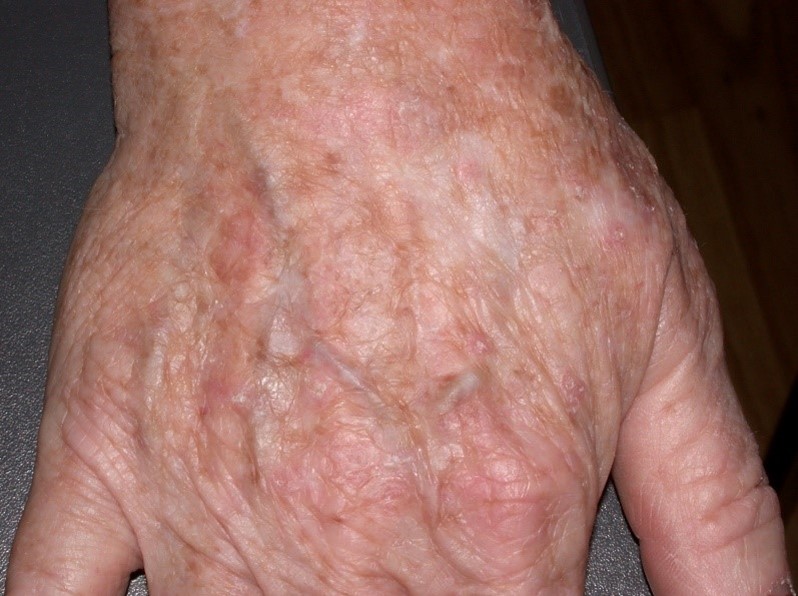Last updated: August 2023
Also known as: Solar keratoses, sunspots
What are actinic keratoses?
Actinic keratoses are pre-cancerous lesions that develop on sun-exposed areas of skin. They most commonly appear as rough, dry and scaly patches on the skin.
Some actinic keratoses may develop into squamous cell carcinoma (SCC).
Who gets actinic keratoses?
Some individuals are more at risk in developing actinic keratoses, such as:
- People with fair skin, pale-coloured eyes, red or blonde hair with a history of sunburn; and
- Older adults
What causes actinic keratoses?
Too much exposure to ultraviolet radiation (UV) from the sun cause nearly all actinic keratoses. UV radiation penetrates the upper layers of the skin and can cause changes to its structure and appearance.
Repeated UV exposure can also damage some of the genetic material (DNA) in skin cells causing chemical changes and mutations. It also impairs the skin’s immune system and its ability to repair any damage.
What do actinic keratoses look like?
The appearance of actinic keratoses can vary:
- A flat or slightly raised scaly patch
- Less than 1mm in size to over 2cm
- Pale, red or brown in colour
- Thickened or warty
Actinic keratoses can occur as a single, isolated lesion, but there are more often multiple. They are commonly found on areas of the body that are regularly exposed to the sun, such as the face, ears, neck, scalp, forearms, backs of hands and lower legs. They may be asymptomatic, itchy or sensitive to touch. Actinic keratoses can also affect the lips and this is known as actinic cheilitis.

Figure 1. Actinic keratoses on the face – Image reproduced with permission of Dr Michelle Hunt

Figure 2. Actinic keratoses on the hand – Image reproduced with permission of Dr Michelle Hunt
How are actinic keratoses diagnosed?
Actinic keratoses are usually diagnosed clinically from their physical appearance.
In some cases, dermoscopy may be useful in diagnosing actinic keratoses. However, in cases of doubt, or if progression to SCC is suspected, a skin sample (biopsy) may be necessary.
How are actinic keratoses treated?
Treatment options will vary depending on the individual and their needs, and whether it is a single keratosis or multiple keratoses being treated.
Actinic keratoses treatment is aimed at preventing the lesions from turning into skin cancers, and improving the appearance and texture of the skin. There are many treatment options available, such as:
- Cryotherapy using liquid nitrogen or “freezing” treatment
- Curettage and cautery (“scraping and burning”)
- Surgical excision (if a skin cancer is suspected)
- Field treatments (which treat the whole affected area), such as 5-Flourouracil cream (a cytotoxic agent) +/- Calcipotriol (a Vit D analogue), Imiquimod cream (an immune-response modifier), Diclofenac gel (an anti-inflammatory), Photodynamic therapy (PDT), chemical peels or laser therapy.
Pretreatment with keratolytics such as salicylic acid or topical retinoid creams may be used to help improve sun damaged skin and improve response to treatment.
What is the likely outcome of actinic keratoses?
Most actinic keratoses can be treated and cured. If they are found and treated early, they may not develop into skin cancer.
In some cases, actinic keratoses may recur months or years after treatment, and new ones are likely to develop. They are also associated with an increased risk of developing skin cancers, particularly SCC.
It is important that a combination of sun protection measures are used, including the wearing of sun protective clothing, correct use of a broad-spectrum sunscreen, wearing of a broad-brimmed hat and sunglasses to reduce the risk of developing new actinic keratoses. Oral Vitamin B3 may also reduce the number and severity of actinic keratoses.
| Dr Michelle Hunt | August 2023 |
| Dr Michelle Hunt | October 2022 |
Disclaimer
2019 © Australasian College of Dermatologists.
You may use for personal use only. Please refer to our disclaimer.